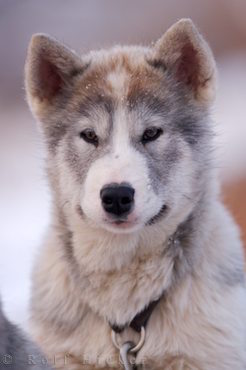
We often hear of dog breeds that were saved from extinction, and here is another one to add to the list: The Canadian Eskimo Dog, one of Canada’s five indigenous dog breeds. Despite having stood at both polar poles and worked with nearly every famous Arctic and Antarctic explorer (a Canadian Eskimo Dog can pull twice its weight through brutal weather and varied terrain with very little nourishment), numbers for this beautiful dog the Inuit called, “Qimmiq,” plummeted in the 1960s. The introduction of the snowmobile, and death from diseases introduced by other breeds that came with population growth in Canada’s north lead to a sad outcome for a breed once so popular that population estimates put breed numbers at over 20,000 dogs. By 1970, less than 200 registered CEDs were left in the world.
In 1972, the Canadian Eskimo Dog Research Foundation was founded with the help of the Canadian Kennel Club and financial support from the Canadian Government. It had one mandate: To save the Canadian Eskimo Dog breed from extinction. Purebred CEDs were acquired from Inuit communities in the north of Canada, as well as from Boothia Peninsula, Melville Peninsula, and Baffin Island. Though the breed has been resurrected, its numbers are still extremely low, and the Canadian Kennel Club has verified that only 279 registered Canadian Eskimo Dogs are in existence.
Canada is trying. In recent years, the breed has been recognized as one of Canada‘s oldest and most authentic breeds. In 1988, it was honored with a postage stamp, and in 1997, it appeared on the fifty-cent piece. In 2000, it was chosen as the animal symbol of the Nunavut territory in Canada.
The CED was once recognized by the AKC in the first half of the 20th century, but was dropped in 1959 because of the small numbers of registered dogs.The FCI (Fédération Cynologique Internationale) does not accept it, but it is recognized by the Canadian Kennel Club as a member of the Working Dog group, as well as by the UKC in the Northern Breed group.
If you’re considering a new breed for yourself, consider the Canadian Eskimo Dog, but only if it’s a good fit for your lifestyle, and you’re a good match for its needs. There is a breed club in Great Britain, For more information on a breed in need of increased numbers, read this and this. If there are any CED owners reading this, we extend an invitation to have their breed highlighted as a Purebred of Interest, simply contact us here for more information.
Image found on Pinterest and happily credited upon receipt of information.

I have lived in Canada’s arctic, and their populations are doing well. The numbers you see are those REGISTERED. Inuit still breed them and use them for dog sled teams, as pets, warning systems for polar bear presence in the community, and protection.
Inuit have no reason to register their dogs; it is not something that is valued in their culture.
Most of the dogs live outside, and the populations are often out of control at times due to not being secured. They are smart and learn very quickly how to live without humans in the extreme arctic weather. Over time, the feral population gets aggressive, and culls are necessary.
Photo: a local dog in Igloolik, Nunavut during the summer.
This is actually good to hear, Nikki, and it makes sense that the dogs aren’t registered as it’s simply not important. We’re glad you shared this update.